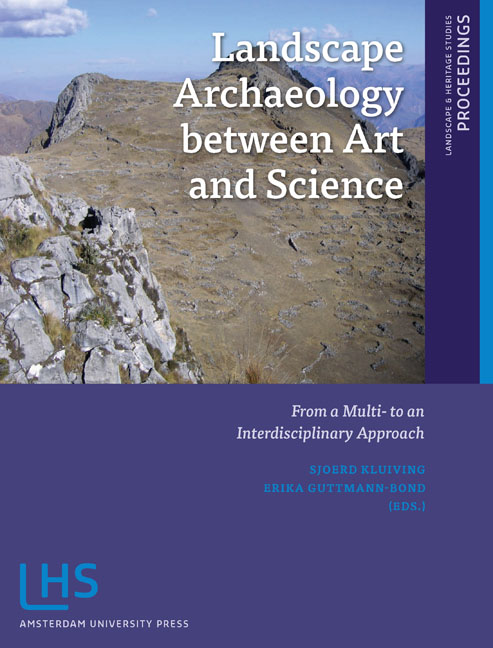Book contents
- Frontmatter
- Contents
- Preface
- Introduction: LAC2010: First International Landscape Archaeology Conference
- THEME 1 HOW DID LANDSCAPE CHANGE?
- THEME II IMPROVING TEMPORAL, CHRONOLOGICAL AND TRANSFORMATIONAL FRAMEWORKS
- THEME III LINKING LANDSCAPES OF LOWLANDS TO MOUNTAINOUS AREAS
- THEME IV APPLYING CONCEPTS OF SCALE
- THEME V NEW DIRECTIONS IN DIGITAL PROSPECTION AND MODELLING TECHNIQUES
- THEME VI HOW WILL LANDSCAPE ARCHAEOLOGY DEVELOP IN THE FUTURE?
- Miscellaneous Endmatter
2.2 - Landscape Transformations in North Coastal Etruria
Published online by Cambridge University Press: 21 January 2021
- Frontmatter
- Contents
- Preface
- Introduction: LAC2010: First International Landscape Archaeology Conference
- THEME 1 HOW DID LANDSCAPE CHANGE?
- THEME II IMPROVING TEMPORAL, CHRONOLOGICAL AND TRANSFORMATIONAL FRAMEWORKS
- THEME III LINKING LANDSCAPES OF LOWLANDS TO MOUNTAINOUS AREAS
- THEME IV APPLYING CONCEPTS OF SCALE
- THEME V NEW DIRECTIONS IN DIGITAL PROSPECTION AND MODELLING TECHNIQUES
- THEME VI HOW WILL LANDSCAPE ARCHAEOLOGY DEVELOP IN THE FUTURE?
- Miscellaneous Endmatter
Summary
ABSTRACT
This paper concerns North coastal Tuscany (ancient Etruria), Italy. Multidisciplinary diachronic research provides evidence of palaeo-environmental changes, of water and risk management practices and of rural and urban landscapes both in the coastal district and the hinterland. From north to south the littoral is articulated in three sections: the Luni – Livorno shoreline, which prograded westwards from the 2nd-1st cent. BC up to about 1830; the Livorno terrace and Livorno-Castiglioncello coastal strip, which are rocky and stable; the Vada – Cecina shoreline, which is low and stable. In the Luni – Livorno district, the coastal and hydrologic evolution strongly affected the sea- and river ports. Three main critical phases are identified, dated to the early 5th century BC, the late Republican- early imperial period and late Antiquity. The cities Pisa, Volterra, Lucca and Luni are examined in their changing landscapes.
KEYWORDS
north coastal Tuscany; Etruria; coastal progradation; Magra, Serchio, Arno, Cecina rivers; Portus Pisanus
TERRITORY AND MULTIDISCIPLINARY RESEARCH
In this paper we study north coastal Etruria, focusing on the littoral area from the Magra to the Cecina rivers and the hinterland with the main rivers lower valleys (Magra, Serchio, Arno, Cecina) (figs.1, 3). From the 6th to the early 2nd centuries BC the northern part of this territory was dominated by Pisa, the southern by Volterra. In the early decades of the 2nd century and the late decades of the 1st century BC the establishment of colonies changed the settlement patterns and had a strong impact on the rural landscapes and the coastal progradation (fig.2).
In this area and its hinterland we run an intensive ‘total archaeology’ research project (Darvill 2001, 36). Diagnostic techniques include geomorphology, palaeogeography, remote sensing, geophysical surveys, archaeological research (including intensive surveys and monitoring of surveyed areas, stratigraphic excavations, underwater archaeology), archaeometric and archaeological studies of finds (metals and pottery), bioarchaeology, the study of ancient and medieval epigraphy, literary sources and toponyms and historical cartography.
The archaeology dates from the late Bronze Age up to the early Medieval period, with our main focus on the late Etruscan, Roman and Late Roman period. At the time of writing the research was still in progress: in this paper we present just part of the results, a few tesserae of a larger mosaic.
- Type
- Chapter
- Information
- Landscape Archaeology between Art and ScienceFrom a Multi- to an Interdisciplinary Approach, pp. 179 - 196Publisher: Amsterdam University PressPrint publication year: 2012
- 1
- Cited by



